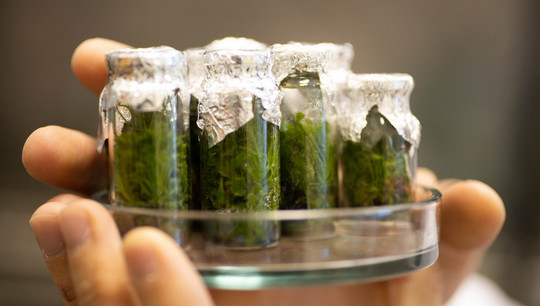Ural Federal University Scientists Make Algae To Produce Bioethanol By Discarding Harmful Substances
Scientists of the Ural Federal University have developed a technology for the production of environmentally friendly bioethanol fuel using waste heat from thermal power plants (TPP) and combined heat and power plants (CHPP) and freshwater algae produced in large quantities in cooling ponds. The use of the technology leads to a reduction in harmful emissions and makes energy production more efficient. The developers emphasize that the technology signifies a transition from hydrocarbon to green energy. An article describing the technology has been published in the International Journal of Hydrogen Energy.
TPPs and CHPPs are the main suppliers of heat, light, and hot water; at the same time, they are sources of greenhouse gas emissions generated during fuel combustion and saturated with carbon dioxide, soot, unburned particles, and various chemical substances. Another byproduct is the so-called waste heat – water heated during the cooling of superheated steam, rotating turbines of TPPs and CHPPs. The waste heat, in the form of steam, evaporates into the atmosphere in large quantities and is discharged together with industrial effluents into storage ponds. Process water containing solutions of hydrochloric acid, caustic soda, ammonia, ammonium salts, iron and other substances is discharged after flushing the flue gases and boiler units.
“As a result of increasing water temperature in water reservoirs, uncontrolled, rapid growth of algae occurs, water blooms, and its quality deteriorates. According to the results of our experiments, we propose to use algae – cassava, elodea and others – as a biofilter for water purification, absorbing dissolved carbon dioxide and other chemical compounds, as well as ash particles. Our experiments have also shown that algae growing randomly in sedimentation ponds or specially grown in them can absorb zinc, magnesium, iron, aluminum, silicon and especially lead. In legumes, which we watered with water purified by algae, the lead content was ten times lower and the plant growth increased significantly,” describes Marina Volkova, head of the research, Senior Lecturer at the Department of Theoretical Mechanics at UrFU.
Water purified by algae fully complies with sanitary standards, it can be discharged into the environment or used for technical and technological purposes, such as hydroponics, without dangerous consequences.
“Used algae is usually disposed of in landfills. However, landfills of spent algae absorbents also pollute the atmosphere, soil and water. Therefore, according to the technology we have developed, after water treatment, the algae is treated with enzymes and decomposed within 1-2 days. Adding yeast to the resulting biomass causes fermentation. In the end, bioethanol is produced – environmentally friendly fuel of the latest generation,” adds Marina Volkova.
Scientists say the same technology can be used to dispose of grass clippings or spoiled fruits and vegetables. This will reduce the carbon dioxide emissions that are released into the atmosphere when they decompose. It has been calculated that one kilogram of algae or other plants can yield up to 300 grams of 70% ethanol. The production of bioethanol from freshwater algae is technologically much simpler than from marine algae, such as in Japan, and does not require the use of chemical processes. The raw material left over after bioethanol extraction can be used as fertilizer and animal feed.
Importantly, the technology developed does not require the construction of additional production facilities. Bioethanol production takes place in the TPP (or CHPP) itself, the corresponding unit is included in the overall production cycle. Moreover, the technology of pollutant absorption by algae with subsequent production of bioethanol can also be used in metallurgy, where the most efficient fuel is coal.
“The implementation of the developed technology leads to a comprehensive solution of a number of problems. The production process at TPPs and CHPPs becomes more environmentally friendly, as the amount of greenhouse gases and pollutants emitted from the surface of the reservoir water is reduced. The water now discharged into the reservoirs is treated with algae and returned to the production cycle, reducing water consumption. Utilization of waste heat reduces heat losses from TPP and CHPP, making production more economical. Algae from waste becomes a source of fertilizer, feed and bioethanol. At the same time, the potential size of the Russian bioethanol market is estimated at 850 million liters, while the actual biofuel production in our country lags far behind the world indicators and is still based on the use of wood,” comments Sergey Shcheklein, Head of the Department of Nuclear Power Plants and Renewable Energy Sources at UrFU.
Professor Shcheklein notes that the world is conventionally divided into two “opposing” groups – supporters of conventional hydrocarbons and green energy based on the use of renewable sources.
“We propose the concept of a transition link from hydrocarbon to green energy, replacing confrontation with joint action,” concludes Sergey Shcheklein.

